|
|
|
|
|
|
More states join Bells of Peace Initiative
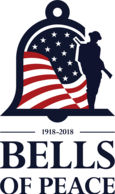 The Governors of Missouri, Illinois and Mississippi have joined the effort
to promote Bells of Peace: A World War I Remembrance by issuing
proclamations asking all their citizens to toll bells on November 11,
2018, in recognition of the centennial of the signing of the Armistice
that ended the fighting in World War I. Bells of Peace is an initiative sponsored by the World War I
Centennial Commission to commemorate the service and sacrifice of those
who served in World War I, and all veterans. The Commission has called on all Americans everywhere to toll bells
21 times, at 5-second intervals, on November 11 at 11:00 a.m. local
time. Read
more about how you and your church, school, community organization,
veterans group, firehouse, or anyone else with a bell to ring can
participate in this growing national commemoration event on November 11,
2018.
|
Ceremony casts new light on nearly forgotten SF monument to WWI fallen
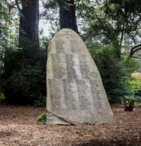 There was a solemn ceremony at noon on Saturday, August 25 at Heroes
Grove, the site of a nearly forgotten monument in Golden Gate Park, to
honor 761 San Franciscans who died in the war to end all wars a century
ago. The monument is an 18-ton granite stone carved with the names of 748
men and 13 women from San Francisco who died in World War I. The site,
called the Grove of Heroes, is surrounded by redwood trees and reached
by an unmarked trail near the park entrance at 10th Avenue and Fulton
Street. “It is a very beautiful place, a quiet spot where you could come and
reflect,” said retired Marine Corps Maj. Gen. J. Michael Myatt, chair of
San Francisco’s World War I Centennial commemoration. Click here to read more about this historic monument and the recent ceremony.
|
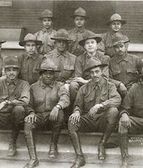 The Herald-Whig newspaper in Quincy, IL continued its fine World War I coverage recently with an in-depth profile of Dr. Hosea J. Nichols, one of the 104 doctors of African-American descent who were physicians in World War I. His father, William Nichols, who had been born a slave, served with
the Union Army in the 59th U.S. Colored Infantry during the Civil War. At the age of 47, Dr. Hosea Nichols volunteered for military
service. He trained at Fort Des Moines, Iowa, which had been a cavalry training
post but was converted to train African-American officers when the
United States entered World War I. Click here to read more about Dr. Hosea Nichols' record of both military any civic service.
|
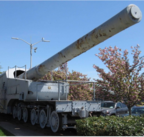 On August 18th, 1918, the U.S. Navy's first naval railway gun, a
14-inch, 50 caliber, Mark IV Navy gun mounted on a railway carriage,
became operational in St. Nazaire, France during World War I. The guns were used to target key infrastructure deep behind the German
lines, and scored some notable successes, including destroying a section of a moving supply train, ripping up an
entire three-track line for a distance of some 100 yards, and scoring a
direct hit on a German troop train with devastating results. Click here to read more about the big guns' contribution to the war effort, and where you can see one of the rail guns today.
|
The Liberation 1918-2018: "The reaction of the audience was overwhelming."
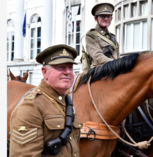 An amazing WWI Living History event has been taking place this past week across Belgium. Called "The Liberation 1918-2018",
the project consists of a column of dozens of WWI reenactors in period
vehicles, wagons, costumes, uniforms, and equipment, who are trekking
across Belgium, following the route of the final counter-offensive of
the war. In Flanders Fields of September 1918 a massive campaign was
launched by Belgian, British, Commonwealth, French and American forces
against the German axis forces in a final effort to end the War of wars
and liberate Belgium. To commemorate this final offensive, a historical
multinational column embarked on an epic journey from Lo-Reninge to
Deinze between 13 and 19 August 2018 -- stopping in several towns, at
every memorial and battlefield to pay due homage to all of those who
made the ultimate sacrifice for our liberty. Click here to read an extensive interview with the leader of this unique living history event, Mr. David Moortgat, President, V.Z.W Platform for Belgian military history.
|
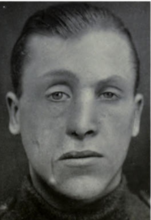 During and after World War I, the blue benches outside London’s Queen’s Hospital were reserved for soldiers who had suffered facial wounds on the Western Front that had never been seen before in warfare. Improvements in anesthesia and treating infections meant that these gruesome battlefield injuries had become survivable, but the facial wounds could be so severe that they left soldiers unable to eat,
drink, or even speak. As terrible as other amputations were, the soldiers who lost
their faces also lost their identities. But inside Queen’s Hospital, pioneering new techniques in plastic surgery and facial reconstruction, born of necessity, helped provide some semblance of normal life to those with these terrible injuries. Click here to read the entire History.com article on the surgeons' work, and how they helped create "hope instead of despair” for their patients.
|
From the World War I Centennial News Podcast
Seth and Garrett Moore Interview
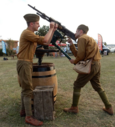 In August 24th's WW1 Centennial News Podcast, Episode 86, Host Theo Mayer spoke with Seth and Garrett Moore, nineteen year old twin brothers with an incredible passion for WW1, originally sparked by family history, when their great-grandmother told them about her uncle who went off to fight the Germans in 1917. Click here to read a transcript of the interview.
|
Observation Balloons
 In August 24th's WW1 Centennial News Podcast, Episode 86, WW1 Tech and Speaking WW1 shared a common theme: Observation Balloons, a crucial but frequently overlooked piece of World War I aviation technology. Click here to read a transcript of the interview.
|
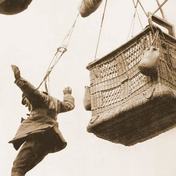 Highlights: #86
Airplanes to end the war? Some say.
Airplanes to end the war? Some say! | @ 02:05
Continued war just out of habit? - Mike Shuster | @ 13:10
Part 3: The 28th Division in Fismette - Dr. Edward Lengel | @ 17:00
The American Legion and ACE - US WWI Commissioner Jack Monahan | @ 24:40
Video Game “11-11 Memories Retold” - Yoan Fanise | @ 30:00
19-year-old twin WWI reenactors - Seth & Garrett Moore | @ 37:45
WW1 War Tech: Observation Balloons | @ 43:45
Speaking WWI: Balloonatic | @ 47:00
Articles & Posts: From the Dispatch Newsletter | @ 48:05
The Buzz: Social Media Highlights - Katherine Akey | @ 50:45
|
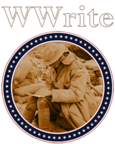 Heroes' Grove: Remembering and Forgetting the Great War in Germany
After war, how does a country commemorate its soldiers in the shadow of defeat and shame? David Eisler explores the question this week at WWrite by analyzing the evolution of a war cemetery in Germany’s Rhein-Neckar Valley. Eisler, a U.S. Army veteran whose writing has appeared in The New York Times, War on the Rocks, The Daily Beast, Collier’s Magazine, Military Review, Drunken Boat, and the anthology of short fiction, The Road Ahead: Fiction from the Forever War, is a PhD candidate at the Heidelberg Center for American Studies in Heidelberg, Germany. His doctoral dissertation focuses on the relationship between American civil-military relations and contemporary war fiction from Vietnam to Iraq and Afghanistan. Read this eloquent, perceptive post about remembering and forgetting Germany's WWI dead.
|
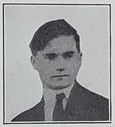 A man is only missing if he is forgotten.
Monday's MIA this week is Private
George J. McDonald. George
McDonald was born June 8th, 1991 in Shoals, Indiana. He was a laborer when he
was called into service on October 6th, 1917 and sent to Camp Taylor, Kentucky
for training. He went ‘Over There’ on April 7th, 1918, and was assigned to
Company G, 28th Infantry, 1st Division. He was lost during the Battle of
Soissons; initially being listed as Missing in Action and that status later
being changed to Killed in Action, though his remains were never located. His
case remains a mystery.
Would you like to help us
solve this case? Give 'Ten For Them' to Doughboy MIA and help us make a full
accounting of the 4,423 American service personnel still listed as
missing in action from WW1. Make your tax deductible donation now, with
our thanks.
|
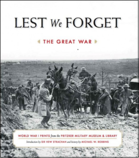
World War I Prints from the Pritzker Military Museum & Library
As
the United States commemorates the centennial of World War I, one of
the nation’s premier military history institutions pays tribute to the
Americans who served and the allies they fought beside to defeat a
resourceful enemy with a lavishly illustrated book.
It is an official product of the United States World War One Centennial
Commission. The story of WWI is told through the memorable art it
spawned―including posters from nations involved in the conflict―and a
taut narrative account of the war’s signal events, its major
personalities and its tragic consequences; and the timely period
photographs that illustrate the awful realities of this revolutionary
conflict. Most importantly, this book is a tribute to those who served in the Army, Navy, Marine Corps and what would become the Air Force. Proceeds from the sale of this book help fund the WW1 Memorial in Washington, DC.
This and many other items are available as Official Merchandise of the United States World War One Centennial.
|

|
|
|
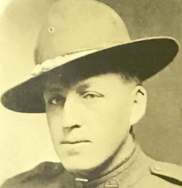
Submitted by: T.J. Cullinane, community historian
John William Tarter born around 1895, John Tarter served in World War 1 with the United States Army . The enlistment was in 1917 and the service was completed in 1919.
Story of Service
John William Tarter was a soldier of the Great War who was felled by disease rather than German bombs and bullets.
He was born in Hartline, Washington on April 3, 1895 to Joseph Henry Tarter
(1862 – 1925) and the former Nancy Ann Epperley (1864 – 1945). Hartline
is a small town in Grant County located in central Washington. Tarter had four siblings: Joseph Clinton Tarter, Bonnie B. Tarter Neal (1886 – 1983), Maude D. Tarter Zetty (1890 – 1979), and Lonnie Clinton (1893 – 1966).
From John’s draft
registration card, we learn that was tall with a medium build and had
blue eyes and dark brown hair. When the United States entered the war in
1917, John was employed as a miner with the Federal Mining and Smelting Company in neighboring Shoshone County, Idaho.
|
|
|
|
|